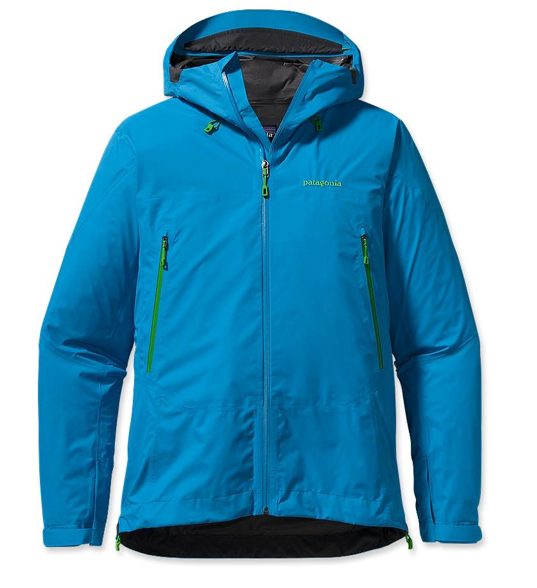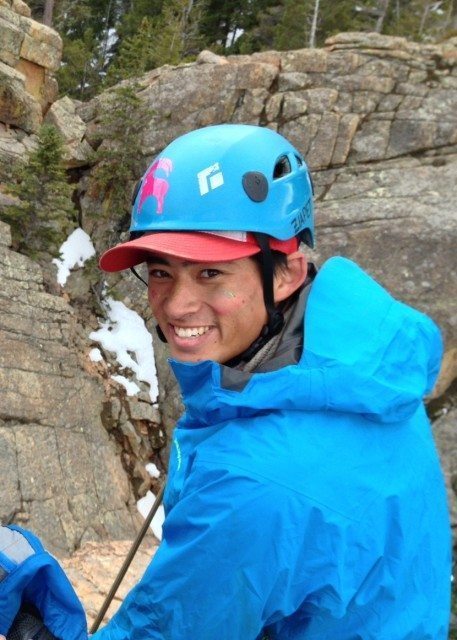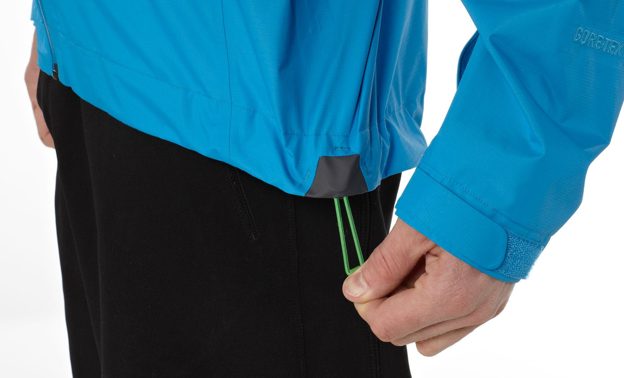
Patagonia Super Cell Jacket
Size: Medium
Weight: 10.8 oz
Fabric: 2-layer Gore-Tex paclite
Features:
- Helmet-compatible, Optimal Visibility Hood™
- Touch Point System™ with embedded cord locks in hood and hem
- Microfleece-lined neck and wind flap
- Full reach gusset panels under arms
- Harness- and pack-compatible pockets with watertight, coated Slim Zips
- Low-profile gusset cuffs
- 2.7-oz 40-denier 100% nylon GORE-TEX® fabric with Paclite® Fabric Technology and a DWR (durable water repellent) finish
MSRP: $260
Days Tested: ~30 (January through June)
Locations: Belize, Colorado; New Hampshire
First Impressions
After finally retiring my 6-year-old hard shell, I went looking for a jacket specifically designed for climbing. As a college student on a budget, I aimed to spend about $250.
The Patagonia Super Cell fits those parameters, so I decided to give it a shot based on my experience with other Patagonia products and the Gore-Tex Paclite membrane. (I’ve worn less expensive jackets made with proprietary waterproof membranes (e.g., Marmot’s PreCip and Mountain Hardwear’s Conduit), and in my experience they haven’t performed as well as a more expensive Gore-Tex membrane.)
Patagonia markets the Super Cell as an ultralight, packable hard shell that—while not as specialized as their M10 jacket—is designed with alpine climbing in mind. It’s not inexpensive at $260, but it’s more affordable than the $400 M10, or the equivalent Arc’teryx Alpha FL.
The Super Cell is a lightweight, versatile shell for climbing that still incorporates features such as pockets and pit zips, which are missing from the M10.
It’s a minimal jacket, so if you’re looking for features like extra pockets, powder skirts, or fleece lining, look elsewhere. But if you want a jacket that packs down small and doesn’t weigh much, the Super Cell should probably be on your list.
Fabric
The Super Cell is made from 2-layer Gore-Tex Paclite fabric, which, as the name suggests, is Gore’s lightest, most packable fabric.
I initially doubted the durability of the Super Cell. The fabric feels a little flimsy, and a jacket intended for climbing and bushwhacking needs to hold up to coarse granite, sharp thorns, and dense branches.
But I found that the Paclite is much more durable than it feels. I have a pair of Marmot Minimalist pants that are constructed with the same fabric, and they’ve held up remarkably well for more than 100 days of climbing, bushwhacking, and skiing.
Sizing and Fit
The Super Cell is sized for climbing. Or rather, it’s sized to fit climbers in awkward positions.
The sleeves and waist are cut long to accommodate a harness and arm movement when climbing. This way the jacket doesn’t ride up while I’m climbing. Too many times I’ve tried a jacket on only to find it rides up out of my harness or I can’t raise my arms above my head without showing some skin at the waist. The Super Cell doesn’t have either of those problems.
I’m one of those people who can reliably count on a medium-size jacket to fit regardless of the brand, and the Super Cell is no exception.
The long sleeves come down to the base of my fingers, and the waist sits just below my hips. The chest and shoulders are still cut athletically and (in my opinion) accurately.
The Super Cell has plenty of space underneath for layers—I’ve layered a fleece and puffy with no loss of mobility—but it is definitely not baggy. Patagonia has veered away from the loose-fitting-outerwear trend in their alpine climbing line.

Hood / Hem Design
I have not used the hood over a ski helmet, but it slides perfectly over a climbing helmet with no decrease in visibility or mobility. Those with large heads may want to double-check on helmet and hood compatibility before making a decision based on this feature though.
When wearing the hood without a helmet, the hood cinches down nicely with the new Patagonia Touch Point adjustment system.

The Touch Point uses shock cord with an integrated adjustment button sewn into the fabric of the jacket. I found it easy to cinch down and easy to make large adjustments, especially while wearing gloves, but tweaking the system on the go was difficult.
Since the whole system is contained within the stitching of the jacket, small adjustments are difficult since you can’t manually pull the cord through the lock button.
When trying to loosen the system, I found that the elastic would only rebound part-way after being cinched down, so I had to push the cord back through the stiching while holding down the button to reset the system.
The Touch Point system works best when you’re wearing gloves and you need to make large adjustments. The buttons are much larger than the small plastic tabs many manufacturers use, making them easy to press even with gloves or mittens on.
The brim of the hood uses a piece of stiff, laminated fabric to hold its shape, with no wires or other structural support. I found the brim held its shape in all but the heaviest rain.
Zippers
The jacket’s zippers—front zip, two pockets, and pit zips—are all weather resistant and rubber coated. They zip up very smoothly, though they sometimes require additional care when unzipping. But I’ve found this to be true of almost every waterproof zipper I’ve ever used.
Each zipper also has its own small zipper garage, neatly placed and well sized.
Pockets, Pit Zips, and Cuffs
The Super Cell’s pockets are placed high on the chest and remain accessible even when you’re wearing a harness or backpack (or both). They’re simple—there are no headphone ports or other features—but they are large and functional.
The pit zips run from the middle of the ribs almost all the way to the elbow. Although arguably an unnecessary addition on a pure alpine climbing jacket, I like this feature on the Super Cell. I think the pit zips make the jacket more versatile, especially on approaches in humid climates like the Northeast.
The Super Cell’s cuffs are cut large, with easy-to-use Velcro adjustments. They expand enough to fit over even my bulkiest gloves, and the Velcro tabs are usable even with gloved hands.
I have had trouble tightening the cuffs enough around bare hands to form a tight seal, but I have fairly small wrists, so your experience may vary.
